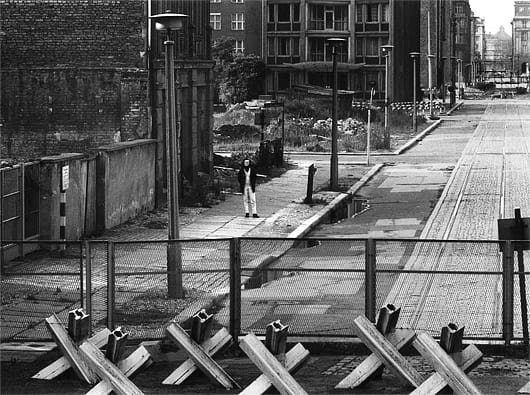01 Nov Encountering the Berlin Wall
In 1974, I was a fresh college graduate when I decided to embark on my first trip abroad. I spent seven months traveling in Western and Eastern Europe, exploring my longtime interest in borders. Even knowing a bit of history, they just seemed so arbitrary. To think there was a man-made demarcation line where one side abided by one set of rules and the other side by another was profoundly intriguing. The United States was so large and so relatively homogeneous it was hard for me to understand the weight of these lines.
My attraction to the epitome of borders, the Iron Curtain, was inevitable. Growing up in America in the 1950s and 1960s this border was emblematic of the line between light and dark, good and evil. And I wanted to experience it first hand to see just how black and white things really were.
I hitchhiked to Berlin in a bakery truck. Westerners could not stop in East Germany but had to transit non-stop to West Berlin — and the deliveryman was going the entire way. The life didn’t seem to change as we crossed that border. Nothing seemed out of place.
After arriving in the city I found a place to stay in the home of an old woman. I asked her if she had any relatives in East Berlin and told her of my plans to cross over. In a grandmotherly tone she gently warned me to be careful.
All Americans had to cross into East Berlin by foot, and there were only a few checkpoints we were allowed to use. I was herded into a small processing room at one of these crossings with many others, all of us crammed in wall-to-wall. But once on the other side, I still remember my initial reaction as I exited into the open sunlight: The sky was still blue, and the grass was still green. I looked for people “shackled by the chains of Communism,” but what I encountered didn’t match the stark differences I had been taught.
I spent the rest of my stay in the city following the wall on both sides of the border. When I got to Checkpoint Charlie, there was a platform we could walk up to that gave a good view at this ground zero of the Cold War. Except for a small family of West Berliners, I was alone. Suddenly, on the other side, a man appeared from around the corner. He stopped and stared at us. It hit me with a rush that he had come to see and be seen by the family standing next to me. They conversed in silence.
After about 10 minutes, the man turned and walked back around the corner. An East German police car followed him. The abandoned buildings along the wall blocked our view, and we waited. No one moved. No one spoke.
Fifteen minutes later, the man once again walked around the corner. This time, he turned in the other direction and gingerly skipped down the street, a sign that all was well. The tension on our platform broke, and the family began to talk and smile.
The grass was green and the sky was blue. But it was very black and white.
Update: This story and photograph have recently been published on the National Public Radio Web site and in Pictory magazine in their online feature 25 Stories of Culture Shock.





Ivan Pope
Posted at 17:20h, 01 NovemberI’m so glad you went. In the early eighties I hitch-hiked up and down Europe and always wanted to go to Berlin. But it just seemed so impossible, a one way hitch to a dead end – it didn’t fit with my hitching ethos. Dumb, really. Then, at the end of the eighties when the wall was coming down, I was an art student. I thought of going and I should have gone. I regret my timidity to this day. I had no children, no ties and a good reason to go. but I didn’t. I sat in London, a few hundred miles away and let history go by.
Carol Beesley
Posted at 18:41h, 01 NovemberIn 1974 I was finishing my first year of teaching at the University of Oklahoma–the wild days for sure. I had teamed up with a friend in the architecture school and we managed to corner funds to bring in guest artists. Robert Morris was on campus and Michel Snow and the group of artists that would do the Cadillac Ranch in Amarillo. Now thirty-five years later I am back to rejoin OU teaching drawing and next fall History of Photo 1945 to the present. No more Berlin Wall. The Cadillac Ranch is still on I-40.
Ivan Pope
Posted at 14:57h, 02 NovemberAnother thing I meant to say is that the wall was my exact contemporary. It went up as I was born in September 1961 and we grew up together. It was a part of my life and I miss it, sorry to say. It came down when I was 29. It’s like I lost a good friend somewhere along the line, but I missed the funeral. Must make art about this some day…
Gary
Posted at 13:57h, 05 NovemberIn 1979, I was stationed in Fulda West Germany and some friends and I drove to East Berlin. It was surreal to drive through the checkpoints, past East German and Russian guards we were told not to make eye contact with because they might decide to mess with us. We had to wear our AF uniforms in East Berlin and refrain from taking pictures of just about anything. A flower was ok, but virtually any building that could conceivably be considered a national security asset was off limits. We were extremely uncomfortable the whole time. West Berlin was a different story. Very vibrant, colorful and alive. In EB, we found ourselves at a large city park, which seemed benign and quiet. Until we started walking through it and out of nowhere came at first a trickle of soldiers, then a torrent from every direction. East German and Russian, all of them glaring at us in our blues, with cameras on our necks, sweating bullets. Certain that any second now they were going to take us into custody and question us for days. Perhaps lock us up for many weeks or months. Turns out, it was a Soviet WWII memorial day and we’d blundered into a public ceremony at the park. We got outta there as fast as our little blue feet could take us, drove back to West Berlin, and never went back. It was maybe the best bit of traveling I ever did in Europe.
Snooker in Berlin
Posted at 08:43h, 03 DecemberI found your image and story (in condensed version) @ Pictorymag.com. When I saw the link for you, I had to follow it.
This picture really spoke to me. The composition is fantastic of course, but that is not the only thing which draws me to it. I just keep going back to the image to see more. Perhaps what is really striking is that you caught that young man and his situation so clearly. On top of this wonderful picture is your well-told story which is like the icing on the cake.
I’ve lived in Berlin for some years now, and really love the city. We just celebrated the 20th year since this horrific border was crushed. The stories which made the news were very much like yours, except these were the people who LIVED them.
Come back to Berlin, you will find a much different city from the one you visited so long ago. But I firmly believe that you will enjoy it, nonetheless.
Jeff
Posted at 09:34h, 03 DecemberThanks Snooker in Berlin. I appreciate your comment. I did go back to Berlin with my wife-to-be in 1992 to show her the city I loved. Of course, it had changed quite a bit since my first trip. And I’m sure it’s changed a lot since my second journey.
You might enjoy the dialogue about this photograph on Flickr. People from around the world were trying to figure out exactly where I had taken the photo. It wasn’t right at Checkpoint Charlie but a block away at Charlottenstraße. We were like detectives trying to place the encounter using photos that might show identifiable buildings.
kanto
Posted at 12:43h, 13 DecemberThank you, Jeff, for posting this image and story; what an incredible image! I spent 6 weeks in West Berlin in the winter of 1981/82, when I stayed with a friend off the Ku’Dam (Kurfürstendamm Straße.) Your photo is redolent of the chilly atmosphere of the city that I experienced back then, when I flew into East Berlin from Greece by way of Sofia; from the sea and open sky into a cold, closed-in, black-and-white world of icy rain.
We landed at Schönefeld airfield, in the eastern sector, and was herded with the other passengers onto an unlabeled bus by armed soldiers, to be driven to the checkpoint into West Berlin. I remember that nobody spoke on that journey. When I left Berlin for Antwerp, I went by train and it was even more like a John le Carré novel: foreigners had to travel through the night and keep the blinds closed. At one point, the train stopped in the middle of nowhere (I peeked) and armed soldiers got on. They collected up all the passports. It seemed like hours before they brought them back and even longer before the train moved again. I have never been so glad to cross a national border as I was that night.
Like you, I also went to look over the Wall from one of those platforms, but all I saw was an empty street and buildings that were still broken and scarred. My friends were underground filmmakers and they showed me a lot of the city, mostly by car at night. In the day we often traveled on the subway, going under the eastern sector and passing through stations with East German soldiers guarding the platforms. One of them took me through the Wall, to the Brandenburg Square. Being German, she drove through one checkpoint by car; I had to go through a subway station checkpoint, be locked in a narrow steel corridor and examined from above by a border guard who charged me 5 DMarks for the privilege. There was nothing to do on the other side except go up the Brandenburgischer Tor and eat a meal in the revolving restaurant.
In the summer of 1990, I went back with a group of fellow artists, driving to Berlin from Hannover. What a difference a regime change makes! We went to the Brandenburg Gate, and walked through to the square and the tower. What had been a deserted, windswept, desolate place was now teeming with people, street performers and stalls. I was astonished by all the colourful neon signage on top of the brutish, communist-era buildings around the square. I took a picture of my feet standing on the remnants of the Wall that far from being solid and seemingly insurmountable, I was astonished to see had been only a foot or so thick.
But then, it’s not walls that keep people imprisoned, is it?